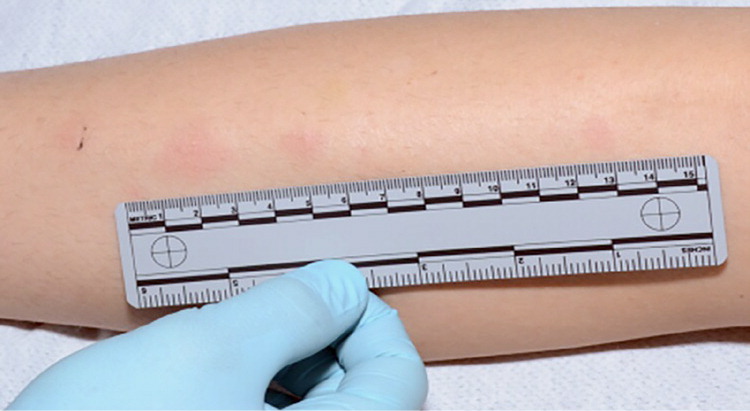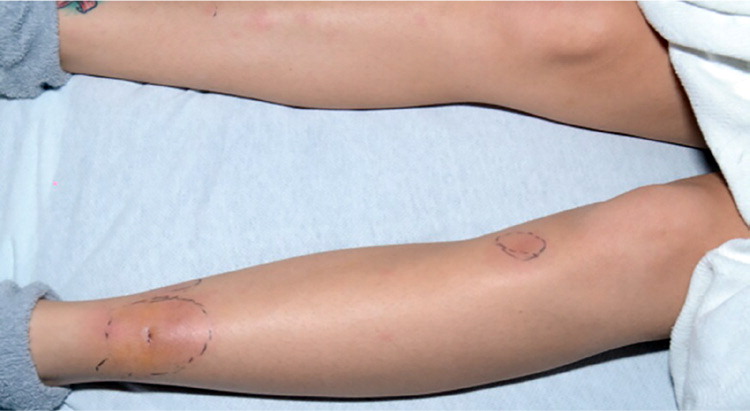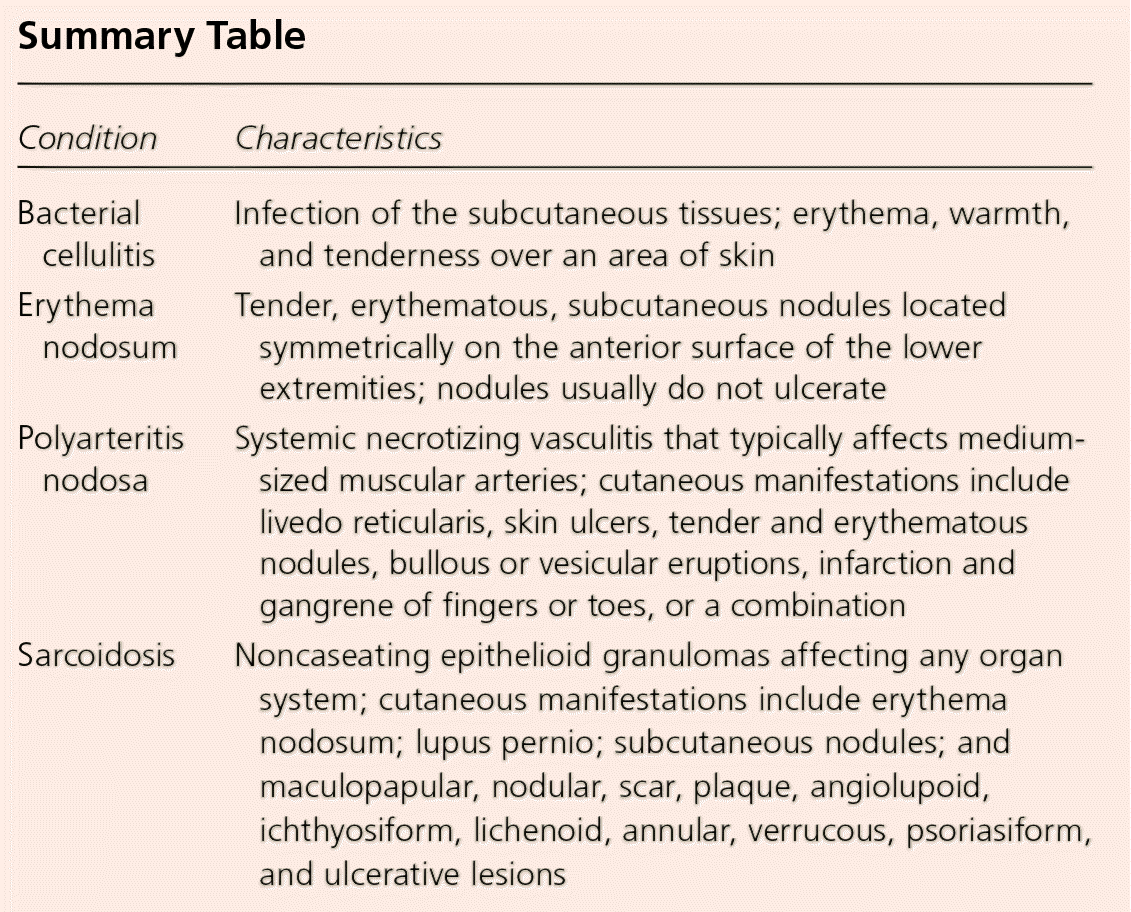
Am Fam Physician. 2016;93(8):701-702
Author disclosure: No relevant financial affiliations.
A 22-year-old pregnant woman (gravida 2, para 1) presented with a sore throat and tonsillar exudates at eight weeks' gestation. Group A rapid streptococcus antigen test results were positive, and streptococcal pharyngitis was diagnosed. She was treated with amoxicillin. On the seventh day of antibiotic treatment, she returned to the clinic with a tender skin nodule on her left anterior leg, and a different antibiotic was prescribed.
On physical examination, the patient had a low-grade fever and multiple erythematous nodules on both of her shins (Figures 1 and 2). The nodules were tender but had no ulceration or drainage. After no response to two weeks of oral antibiotic therapy, she was admitted to the hospital and intravenous antibiotics were initiated. A wound culture had no bacterial growth, and a complete blood count was within normal limits.


Question
Discussion
The answer is B: erythema nodosum. Erythema nodosum is a hypersensitivity reaction that causes inflammation of the subcutaneous fat. Up to 50% of cases are idiopathic, but the condition can be triggered by a wide variety of stimuli. Causes include medications, such as oral contraceptives and antibiotics including penicillins and sulfonamides; infections, most commonly streptococci; pregnancy; systemic illnesses, such as sarcoidosis and inflammatory bowel disease; and malignancies, such as lymphoma. Erythema nodosum typically presents in the teens and 20s and is more common in women.1
Erythema nodosum presents as tender, erythematous, subcutaneous nodules that are 1 to 10 cm in diameter. The lesions are typically located symmetrically on the anterior surface of the lower extremities. Nodules often take one to two months to heal completely but usually do not ulcerate. After the history and physical examination, evaluation should include testing for streptococcal infection, as well as risk stratification for tuberculosis. Erythema nodosum is typically self-limited. Pain can be managed with nonsteroidal anti-inflammatory drugs. Any underlying disorders should be treated and supportive care provided.2 This patient has multiple factors associated with erythema nodosum, including streptococcal pharyngitis, antibiotic treatment, and pregnancy.
Bacterial cellulitis is an infection of the dermis and subcutaneous tissues that is characterized by edema, warmth, and tenderness over an area of skin. Cellulitis commonly occurs near breaks in the skin, such as surgical wounds, trauma, or ulcerations, but occasionally presents in normal skin. Patients may have a fever and an elevated white blood cell count.3
Polyarteritis nodosa is a systemic necrotizing vasculitis that typically affects medium-sized muscular arteries and occasionally small muscular arteries, resulting in secondary tissue ischemia. The kidneys, skin, joints, muscles, peripheral nerves, and gastrointestinal tract are most commonly affected. Cutaneous manifestations include livedo reticularis, skin ulcers, tender erythematous nodules, bullous or vesicular eruptions, infarction and gangrene of fingers or toes, or a combination. Unlike with erythema nodosum, the nodules in polyarteritis nodosa can ulcerate.4
Sarcoidosis is characterized by noncaseating epithelioid granulomas affecting any organ system. The disease most commonly involves granuloma formation in the lungs, with some pulmonary involvement in 90% to 95% of cases. Dermatologic manifestations occur in 25% of patients with sarcoidosis. Specific lesions manifest as noncaseating granulomas, whereas nonspecific lesions do not reveal granulomas on histopathologic examination. Erythema nodosum is the main nonspecific cutaneous disease. Specific cutaneous diseases include lupus pernio; subcutaneous nodules; and maculopapular, nodular, scar, plaque, angiolupoid, ichthyosiform, lichenoid, annular, verrucous, psoriasiform, and ulcerative lesions.5

| Condition | Characteristics |
|---|---|
| Bacterial cellulitis | Infection of the subcutaneous tissues; erythema, warmth, and tenderness over an area of skin |
| Erythema nodosum | Tender, erythematous, subcutaneous nodules located symmetrically on the anterior surface of the lower extremities; nodules usually do not ulcerate |
| Polyarteritis nodosa | Systemic necrotizing vasculitis that typically affects medium-sized muscular arteries; cutaneous manifestations include livedo reticularis, skin ulcers, tender and erythematous nodules, bullous or vesicular eruptions, infarction and gangrene of fingers or toes, or a combination |
| Sarcoidosis | Noncaseating epithelioid granulomas affecting any organ system; cutaneous manifestations include erythema nodosum; lupus pernio; subcutaneous nodules; and maculopapular, nodular, scar, plaque, angiolupoid, ichthyosiform, lichenoid, annular, verrucous, psoriasiform, and ulcerative lesions |
The opinions and assertions contained herein are the private views of the authors and are not to be construed as official or as reflecting the views of the U.S. Navy Medical Department or the U.S. Navy at large.
